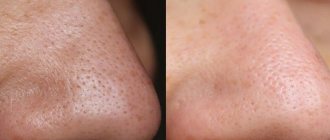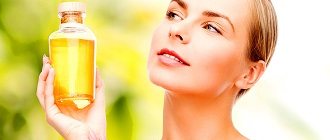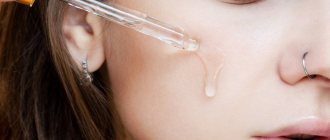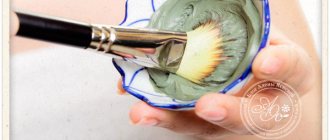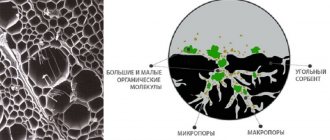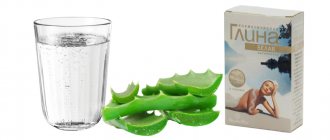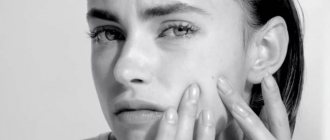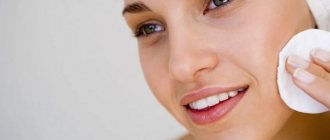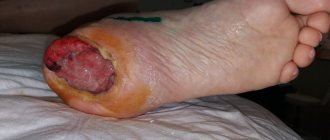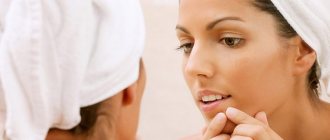Why do blackheads* appear on the chin?
Open comedones are formed against the background of increased secretion of the sebaceous glands. Pores quickly become clogged with sebum, cosmetic residues, dust particles, and dirt. Sebaceous plugs acquire black color due to the oxidation of tyrosine, as well as the formation of melanin. [176]
This problem is most often encountered by those with combination and oily skin. Black spots* form on the nose and chin, as well as on the forehead. Moreover, the reasons for their appearance can be different: from hormonal imbalance and heredity to stress, bad habits and poor nutrition. [176]
Irregular or improper skin care can also provoke the appearance of open comedones. Pores usually become clogged due to insufficient cleansing and the use of comedogenic products (mineral oils, talc, etc.) [176]
Causes of blackheads
Black dots on the face, otherwise called comedones, appear in most people, this occurs especially actively during the period of hormonal changes - in adolescence, in women - before menstruation, during pregnancy. With the onset of old age, the production of sebum and sweat decreases, so the rashes go away on their own.
Androgens have the greatest influence on the functioning of the skin glands. In adolescents, a physiological jump in blood concentration occurs, both in boys and girls, even before the appearance of the first menstruation. But not all teenagers develop pronounced cosmetic defects. Sometimes there is an increased sensitivity of the sebaceous glands to androgens, then even normal levels of the hormone will lead to skin defects.
Hormonal causes of blackheads in women are associated with gynecological diseases. With polycystic ovary syndrome, the maturation of the follicle in the ovaries is disrupted, so the concentration of androgens in the blood increases. The skin pores secrete a lot of sebum, so the face always looks oily.
The appearance of blackheads is also associated with other factors:
- Poor personal hygiene – if you are prone to comedones, you need to properly cleanse your face. If at the end of the day you do not remove dirt and dust particles, they will clog the pores even more, creating conditions for the proliferation of bacteria and the appearance of inflammation.
- Poor nutrition – blackheads occur in people who eat large amounts of fatty, sweet and starchy foods.
- Disruption of the digestive tract - the condition of the skin reflects the health of the intestines and stomach; with chronic pathologies, the production of sebum may change.
- Inappropriate cosmetics - if the skin looks oily, it is necessary to use special non-comedogenic creams that do not clog pores.
Cosmetics can worsen the condition of skin with blackheads, increase the number of clogged pores or cause inflammation. When choosing a cosmetic product, it is necessary to avoid mineral oils. Lanolin, squalene and red coloring pigments are dangerous for the skin. You also need to read where the cosmetics came from and the expiration date.
Propionic bacteria may be the cause of blackheads. They are opportunistic microflora of the skin, but are able to penetrate the ducts of the glands, increasing their activity and the volume of sebum secreted. The pores become clogged with secretions, and bacteria stimulate excessive keratinization of the edges of the pores. Therefore, black comedones are constantly present on the face, and after squeezing them out, enlarged pores remain.
Comedones on the face are formed with the development of hyperkeratosis. This is a condition that develops under the influence of unfavorable external factors, a lack of vitamin A. Hyperkeratosis is caused by intoxication while working in hazardous industries, contact with petroleum products, and industrial dust.
Sometimes it is impossible to determine why blackheads appear. They can be associated with a hereditary factor. But it is not the comedones themselves that are transmitted, but increased sensitivity to sex hormones or the peculiarities of sebum production.
Does aspirin help with blackheads*?
Aspirin is acetylsalicylic acid, the production of which involves various components, including salicylic acid. It has anti-inflammatory, antibacterial, comedolytic effects. Therefore, salicylic acid is often prescribed for acne. [13, 72]
Aspirin has antibacterial properties and helps suppress excessive secretion of the sebaceous glands and inflammatory processes. The active effect of the tablets is based on increasing blood flow to the upper layers of the epidermis. This helps to saturate tissues with vitamins and improves their nutrition. [197]
It is believed that masks against blackheads* with Aspirin have a complex effect [197]:
- suppress inflammation;
- moisturize, whiten, dry the skin;
- prevent the spread of infection;
- relieve swelling from irritated skin.
But homemade cosmetics based on Aspirin cannot be called safe. The fact is that the tablets contain chemicals that have nothing to do with skin care. Therefore, a mask with Aspirin is unlikely to help get rid of blackheads* at home. [72]
Operating principle of ultrasound
The cleaning effect of ultrasound is based on high frequency vibrations. Ultrasound waves emitted by a metal plate exert alternating acoustic pressure on a conductive substance, which must be applied to the skin before the procedure. As a result, microjets are formed that weaken the bonds between the keratinized cells of the stratum corneum, facilitating their easy removal.
The procedure has not only cleansing effects, but also other effects:
- micromassage;
- activation of redox processes;
- skin hydration;
- stimulating effect on the synthesis of collagen and elastin;
- acceleration of skin cell regeneration.
But these effects are weakly expressed, since ultrasonic waves penetrate only 0.2 mm during the cleaning procedure.
But you can expect the following effects from ultrasonic cleaning:
- local inflammatory process decreases;
- the skin acquires a healthy tone;
- pores are cleared of blackheads;
- skin elasticity increases.
Can aspirin harm the skin?
To obtain acetylsalicylic acid, sulfuric acid and acetic anhydride are added to salicylic acid. These substances, if used inappropriately, can be harmful. [72]
Acetic anhydride can cause swelling, erythema, and lead to irritation. This is especially true when a mask with Aspirin is applied to damaged skin of the nose, forehead or chin with blackheads.
Sulfuric acid is attributed to toxicity. When used externally, it can cause irritation, burning, and itching.
There are situations in which the danger of using Aspirin for cosmetic purposes increases several times:
- Too many tablets used. The risk to the skin increases if you make masks using a whole pack of Aspirin.
- A homemade mask is applied to damaged skin, for example, after squeezing out blackheads or comedones.
- The product is left on the skin for a long time. Many patients have the misconception that the longer the mask is on the face, the stronger the effect. This misconception can cost you the health and beauty of your skin.
It is better to avoid experiments with self-preparing masks based on medications. Especially if they are not intended to treat acne.
How is ultrasonic cleaning performed?
Ultrasonic peeling is carried out in several stages:
- Makeup remover Makeup is removed using a special product, and sometimes cold hydrogenation is carried out.
- Attaching the passive electrode. It is not always used, but some devices have special bracelets that are put on the patient’s hand before the procedure.
- Hydration. The cleansing effect of the procedure can only be achieved in a liquid medium, so a special gel is applied to the skin.
- Cleaning. The cosmetologist holds the device at an angle of 35-45°, moving over the skin.
- The final stage. The specialist gives a light massage. Masks or creams can be used.
All stages of the procedure can take 60-90 minutes. The cleaning itself using the device takes approximately 15 minutes. The frequency of sessions is determined by the cosmetologist, based on the individual characteristics of the client’s skin.
Blackheads* on the chin: how to get rid of them at home?
First of all, it is necessary to change your lifestyle and improve the quality of your diet. Experts recommend excluding fast food, sweet carbonated drinks, chocolate, spicy and salty foods. The diet should consist of cereals, greens, fresh fruits and vegetables, and fish. [176]
Don't forget to stay hydrated and try to quit smoking. Minimize your alcohol consumption and be sure to take care of your skin. It’s better to entrust this matter to a good cosmetologist, because he knows exactly how to remove blackheads* on the chin. Self-removal of sebaceous plugs often leads to injury and inflammation of the skin. [176]
Recommendations
It is important to remember that during manual cleaning, no matter how delicately a specialist acts, redness and swelling may appear on the skin. Allergic reactions and peeling may occur from other types of cosmetic procedures. This is why it is not recommended to cleanse your face of acne on the eve of a significant event. It is better to do all the necessary manipulations a week before the important day.
On the day of the prescribed cleansing of the epidermis, you should avoid water-thermal procedures, such as a sauna, bathhouse, SPA, or swimming pool. You also need to avoid activities that cause profuse sweating, so it is better to refrain from attending intense sports training 2-3 hours before for cosmetic procedures. Only hygienic showering and washing are possible.
It is not recommended to use decorative cosmetics, as well as dyeing hair, eyebrows and eyelashes in the 12 hours following the procedure. During this same time, home care should consist exclusively of washing and using those products that the cosmetologist directly recommends.
Blackheads* on the face: how to get rid of them?
Open comedones are not only an aesthetic problem. They often indicate the onset of acne. If, in addition to blackheads*, you periodically experience inflammatory elements, consult a dermatologist.
In the treatment of mild to moderate acne, azelaic acid, for example, Azelik® gel, can be prescribed. [9] The drug helps reduce the level of free fatty acids [5].
The drug exhibits antimicrobial activity against Propionibacterium acnes and Staphylococcus epidermidis and helps normalize keratinization processes. Azelik® gel has an anti-inflammatory effect. This is explained by its ability to reduce the metabolism of neutrophils and their production of free radical forms of oxygen. [5]
*acne
Clinical manifestations
Enlarged pores on the face appear as visible round or irregular crater-shaped depressions on the skin ( Fig. 1 ). Their number on the cheeks varies on average from 10 to 90 pcs/cm2. In the literature, the facial topography with enlarged pores is sometimes compared to the surface of a golf ball ( Fig. 2 ).
There are very few studies on this topic, but there is data on the density of enlarged pores among various ethnic groups, obtained from a survey of more than 2,500 women aged 18–80 years from various countries around the world ( Table 1 ).
Table 1. Average number of enlarged pores per square centimeter of skin depending on the ethnicity and age of women (Flament F., Francois G., Qiu H., et al. Facial skin pores: a multiethnic study. Clin Cosmet Investig Dermatol 2015; 8: 85–93)
| Ethnic group | 18–29 years old | 30–39 years old | 40–49 years old | 50–59 years old | 60–69 years old | >70 years |
| Europeans | 63,96 | 62,22 | 64,49 | 59,93 | 61,13 | – |
| Brazilians | 91,26 | 81,75 | 68,7 | 61,73 | – | – |
| Indians | 82,68 | 79,91 | 77,12 | 77,53 | 73,56 | 71,19 |
| Chinese | 21,13 | 23,24 | 20,77 | 24,51 | 20,20 | 21,66 |
| Japanese | 67,41 | 69,64 | 69,78 | 72,44 | 69,75 | 68,83 |
As you can see, the skin of women living in China has the fewest enlarged pores, while women living in Brazil have the most enlarged pores. Women in European countries occupy an intermediate position. You can also notice a tendency for the number of enlarged pores to decrease with age.
Rice . 1. Enlarged pores on the face (American Academy of Dermatology, AAD)
Rice. 2. Skin with enlarged pores resembles the surface of a golf ball.

